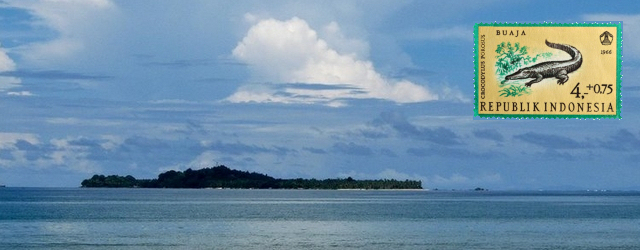Tiny Ternate and its marine motifsHemmed in between Pantar and Alor are the islands of Ternate and Buaya. The former, barely more than a rock rising up in the narrow strait, is not to be confused by the much larger island in the northern Moluccas, after which it was named. The local population associates the introduction of weaving with the advent of Islam in the reign of the Sultan Babullah (1580�1583), ruler of the powerful state of Ternate to the north, which for centuries dominated trade in the eastern Indonesian islands. The main ikat producing centre is the village of Uma Pura, which has a large well, the only one on the island.Swedish ethnographer Emilie Wellfelt observed that the economic circumstances are marked by a lack of resources. "An old woman summarized conditions in Ternate: 'Here on the island is nothing. Everything has to be bought: rattan, wood, salt, vegetables, cassava. The only thing that can be grown is maize and beans. If you sit down and do nothing for one day�all is lacking.' . . . In Uma Pura [Ternate] raw food is regarded as personal property, if not consumed it can be sold or bartered. Prepared food is common property, if somebody asks for food it has to be given." There is hardly any arable land, which is why the islanders were granted use of some land on western Alor, and why growing much cotton there instead of food was out of the question. To relieve the shortage, the men of Ternate would sail all the way to Lembata in their small prahus to barter clay cooking pots made on the island, said to give a nice fragrance to rice, for cotton. The exchange rate was fixed at the amount of raw cotton that could be stuffed into a pot. Buaya, the salt water crocodileJust a mile and a half off the west coast of Alor lies the tiny island of Buaya, the name of which means 'crocodile', here specifically the salt water crocodile, which will swim up rivers where it finds them, but also crosses sea straits. Looking at the island from a beach on Alor it is easy to sea how the island got its name: the profile is exactly that of a large crocodile. On some maps the island is named Kisu, which may well be its original name. Perhaps Buaya is just a nickname that stuck. Buaya as seen from western Alor. Photo courtesy Martin Jendrichowski, 2012. Stamp issued in 1966, with the name of the island still in the colonial spelling. A spelling reform in 1972 brought the spelling of Bahasa Indonesia in line with Malaysian Malay.
Buaya as seen from western Alor. Photo courtesy Martin Jendrichowski, 2012. Stamp issued in 1966, with the name of the island still in the colonial spelling. A spelling reform in 1972 brought the spelling of Bahasa Indonesia in line with Malaysian Malay.
The most remarkable thing about Buaya is that it is populated, although - according to our Alorese informants - there is no water on the island. Indeed on the beach near Alor Kecil we saw men loading bambu air, long and thick bamboo vessels, into a sailing prahu bound for the island. As for how people survive: helping each other probably is central to the social relations, and vital for survival. Emilie Wellfelt, who studied the neighbouring islet of Ternate, where conditions are very similar observed that the economic circumstances are marked by a lack of resources. "An old woman summarized conditions in Ternate: 'Here on the island is nothing. Everything has to be bought: rattan, wood, salt, vegetables, cassava. The only thing that can be grown is maize and beans. If you sit down and do nothing for one day - all is lacking.' [..] In Uma Pura [Ternate] raw food is regarded as personal property, if not consumed it can be sold or bartered. Prepared food is common property, if somebody asks for food it has to be given." The second most remarkable thing is that the island's women manage to create ikat sarongs, which are made during the dry season when they cannot work on their plots, and are bartered for foodstuffs and clothing on markets on Alor, mostly in Alor Kecil. Aquatic motifs with naturalistic representation predominate, especially fish, manta rays and turtles. The weaving is rather uneven, certainly compared with the best Alor pieces. They do have a particular charm though, especially when the colours, such as in our one Buaya piece, are made with natural dyes and well saturated. We do not know of Buaya ikat in museums, but we do know of a few pieces in private collections. |



